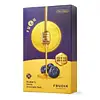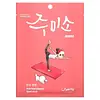What's inside
What's inside
 Key Ingredients
Key Ingredients

 Benefits
Benefits

 Concerns
Concerns

 Ingredients Side-by-side
Ingredients Side-by-side

Water
Skin ConditioningButylene Glycol
HumectantCetyl Ethylhexanoate
EmollientPentaerythrityl Tetraethylhexanoate
EmollientVaccinium Angustifolium Fruit Extract
Skin ProtectingPolyglyceryl-3 Methylglucose Distearate
EmulsifyingGlyceryl Stearate Se
EmulsifyingGlycerin
HumectantDiisostearyl Malate
EmollientButyrospermum Parkii Butter
Skin ConditioningCetyl Alcohol
EmollientTrehalose
HumectantGlyceryl Caprylate
EmollientBetaine
HumectantCoco-Caprylate/Caprate
EmollientStearyl Alcohol
EmollientTromethamine
BufferingCoptis Japonica Root Extract
Skin ConditioningCarbomer
Emulsion Stabilising1,2-Hexanediol
Skin ConditioningMyristyl Alcohol
EmollientXanthan Gum
EmulsifyingAcrylates/C10-30 Alkyl Acrylate Crosspolymer
Emulsion StabilisingLauryl Alcohol
EmollientHydrogenated Olive Oil Unsaponifiables
EmollientDisodium EDTA
Hyaluronic Acid
HumectantSodium Hyaluronate
HumectantPanthenol
Skin ConditioningTheobroma Cacao Extract
Skin ConditioningVitis Vinifera Seed Oil
EmollientPrunus Armeniaca Kernel Oil
MaskingRibes Nigrum Leaf Extract
PerfumingHoney Extract
HumectantSolanum Lycopersicum Seed Oil
EmollientPunica Granatum Seed Oil
EmollientMangifera Indica Seed Oil
EmollientCitrus Paradisi Seed Oil
PerfumingCitric Acid
BufferingTocopherol
AntioxidantChlorphenesin
AntimicrobialWater, Butylene Glycol, Cetyl Ethylhexanoate, Pentaerythrityl Tetraethylhexanoate, Vaccinium Angustifolium Fruit Extract, Polyglyceryl-3 Methylglucose Distearate, Glyceryl Stearate Se, Glycerin, Diisostearyl Malate, Butyrospermum Parkii Butter, Cetyl Alcohol, Trehalose, Glyceryl Caprylate, Betaine, Coco-Caprylate/Caprate, Stearyl Alcohol, Tromethamine, Coptis Japonica Root Extract, Carbomer, 1,2-Hexanediol, Myristyl Alcohol, Xanthan Gum, Acrylates/C10-30 Alkyl Acrylate Crosspolymer, Lauryl Alcohol, Hydrogenated Olive Oil Unsaponifiables, Disodium EDTA, Hyaluronic Acid, Sodium Hyaluronate, Panthenol, Theobroma Cacao Extract, Vitis Vinifera Seed Oil, Prunus Armeniaca Kernel Oil, Ribes Nigrum Leaf Extract, Honey Extract, Solanum Lycopersicum Seed Oil, Punica Granatum Seed Oil, Mangifera Indica Seed Oil, Citrus Paradisi Seed Oil, Citric Acid, Tocopherol, Chlorphenesin
Water
Skin ConditioningGlycerin
HumectantMethylpropanediol
SolventPEG-60 Hydrogenated Castor Oil
EmulsifyingBetaine
HumectantCarbomer
Emulsion StabilisingHydroxyethylcellulose
Emulsion StabilisingXylitylglucoside
HumectantXanthan Gum
EmulsifyingAnhydroxylitol
HumectantButylene Glycol
HumectantArginine
MaskingScutellaria Baicalensis Root Extract
AstringentGlyceryl Caprylate
EmollientCaffeine
Skin ConditioningPEG-32
HumectantAllantoin
Skin ConditioningXylitol
HumectantArgania Spinosa Kernel Oil
EmollientEthylhexylglycerin
Skin ConditioningPanthenol
Skin ConditioningNiacinamide
SmoothingDisodium EDTA
Glucose
HumectantSodium Starch Octenylsuccinate
AbsorbentAloe Barbadensis Leaf Juice
Skin ConditioningCalcium Pantothenate
Maltodextrin
Absorbent1,2-Hexanediol
Skin ConditioningSodium Ascorbyl Phosphate
AntioxidantTriethylhexanoin
MaskingButyrospermum Parkii Butter
Skin ConditioningTocopheryl Acetate
AntioxidantPyridoxine Hcl
Skin ConditioningCaprylyl Glycol
EmollientHydrogenated Lecithin
EmulsifyingPhenoxyethanol
PreservativeCeramide 3
Skin ConditioningPanax Ginseng Root Extract
EmollientPueraria Lobata Root Extract
HumectantPaeonia Lactiflora Root Extract
Skin ConditioningDioscorea Japonica Root Extract
Skin ConditioningSaccharomyces Ferment Filtrate
HumectantLactobacillus Ferment
Skin ConditioningCeramide 2
Skin ConditioningSilica
AbrasiveChlorphenesin
AntimicrobialDehydroacetic Acid
PreservativeParfum
MaskingHexyl Cinnamal
PerfumingLimonene
PerfumingLinalool
PerfumingWater, Glycerin, Methylpropanediol, PEG-60 Hydrogenated Castor Oil, Betaine, Carbomer, Hydroxyethylcellulose, Xylitylglucoside, Xanthan Gum, Anhydroxylitol, Butylene Glycol, Arginine, Scutellaria Baicalensis Root Extract, Glyceryl Caprylate, Caffeine, PEG-32, Allantoin, Xylitol, Argania Spinosa Kernel Oil, Ethylhexylglycerin, Panthenol, Niacinamide, Disodium EDTA, Glucose, Sodium Starch Octenylsuccinate, Aloe Barbadensis Leaf Juice, Calcium Pantothenate, Maltodextrin, 1,2-Hexanediol, Sodium Ascorbyl Phosphate, Triethylhexanoin, Butyrospermum Parkii Butter, Tocopheryl Acetate, Pyridoxine Hcl, Caprylyl Glycol, Hydrogenated Lecithin, Phenoxyethanol, Ceramide 3, Panax Ginseng Root Extract, Pueraria Lobata Root Extract, Paeonia Lactiflora Root Extract, Dioscorea Japonica Root Extract, Saccharomyces Ferment Filtrate, Lactobacillus Ferment, Ceramide 2, Silica, Chlorphenesin, Dehydroacetic Acid, Parfum, Hexyl Cinnamal, Limonene, Linalool
Ingredients Explained
These ingredients are found in both products.
Ingredients higher up in an ingredient list are typically present in a larger amount.
1,2-Hexanediol is a synthetic liquid and another multi-functional powerhouse.
It is a:
- Humectant, drawing moisture into the skin
- Emollient, helping to soften skin
- Solvent, dispersing and stabilizing formulas
- Preservative booster, enhancing the antimicrobial activity of other preservatives
Betaine is a common humectant (a substance that promotes retention of moisture). It's known to be gentle on the skin and can help balance hydration.
This ingredient is best for improving hydration and soothing irritated skin. Studies also show it helps even out skin tone.
Fun fact: Betaine is naturally created in the skin and body. The kind found within cosmetic products can be either plant-derived or synthetic.
Another name for betaine is trimethylglycine.
Learn more about BetaineButylene Glycol (or BG) is used within cosmetic products for a few different reasons:
Overall, Butylene Glycol is a safe and well-rounded ingredient that works well with other ingredients.
Though this ingredient works well with most skin types, some people with sensitive skin may experience a reaction such as allergic rashes, closed comedones, or itchiness.
Learn more about Butylene GlycolThis ingredient is also known as shea butter. It is an effective skin hydrator and emollient.
Emollients help soothe and soften your skin. It does this by creating a protective film on your skin. This barrier helps trap moisture and keeps your skin hydrated. Emollients may be effective at treating dry or itchy skin.
Shea butter is rich in antioxidants. Antioxidants help fight free-radicals, or molecules that may harm the body. It is also full of fatty acids including stearic acid and linoleic acid. These acids help replenish the skin and keep skin moisturized.
While Shea Butter has an SPF rating of about 3-4, it is not a sunscreen replacement.
Shea butter may not be fungal acne safe. We recommend speaking with a professional if you have any concerns.
Learn more about Butyrospermum Parkii ButterCarbomer is a polymer of acrylic acid. Its main role is to create a gel consistency.
A high amount of carbomer can cause pilling or balling up of products. Don't worry, most products contain 1% or less of carbomer.
Chlorphenesin is a synthetic preservative. It helps protect a product against bacteria in order to extend shelf life. In most cases, Chlorphenesin is paired with other preservatives such as phenoxyethanol and caprylyl glycol.
Chlorphenesin is a biocide. This means it is able to help fight the microorganisms on our skin. It is also able to fight odor-releasing bacteria.
Chlorphenesin is soluble in both water and glycerin.
Studies show Chlorphenesin is easily absorbed by our skin. You should speak with a skincare professional if you have concerns about using Chlorphenesin.
Learn more about ChlorphenesinDisodium EDTA plays a role in making products more stable by aiding other preservatives.
It is a chelating agent, meaning it neutralizes metal ions that may be found in a product.
Disodium EDTA is a salt of edetic acid and is found to be safe in cosmetic ingredients.
Learn more about Disodium EDTAGlycerin is already naturally found in your skin. It helps moisturize and protect your skin.
A study from 2016 found glycerin to be more effective as a humectant than AHAs and hyaluronic acid.
As a humectant, it helps the skin stay hydrated by pulling moisture to your skin. The low molecular weight of glycerin allows it to pull moisture into the deeper layers of your skin.
Hydrated skin improves your skin barrier; Your skin barrier helps protect against irritants and bacteria.
Glycerin has also been found to have antimicrobial and antiviral properties. Due to these properties, glycerin is often used in wound and burn treatments.
In cosmetics, glycerin is usually derived from plants such as soybean or palm. However, it can also be sourced from animals, such as tallow or animal fat.
This ingredient is organic, colorless, odorless, and non-toxic.
Glycerin is the name for this ingredient in American English. British English uses Glycerol/Glycerine.
Learn more about GlycerinGlyceryl Caprylate comes from glycerin and caprylic acid, a fatty acid from coconut. It has emollient and emulsifier properties.
As an emollient, it helps hydrate your skin. Emollients work by creating a barrier on your skin to trap moisture in, helping to keep your skin soft and smooth.
On the other hand, emulsifiers prevent ingredients (such as oil and water) from separating.
Learn more about Glyceryl CaprylatePanthenol is a common ingredient that helps hydrate and soothe the skin. It is found naturally in our skin and hair.
There are two forms of panthenol: D and L.
D-panthenol is also known as dexpanthenol. Most cosmetics use dexpanthenol or a mixture of D and L-panthenol.
Panthenol is famous due to its ability to go deeper into the skin's layers. Using this ingredient has numerous pros (and no cons):
Like hyaluronic acid, panthenol is a humectant. Humectants are able to bind and hold large amounts of water to keep skin hydrated.
This ingredient works well for wound healing. It works by increasing tissue in the wound and helps close open wounds.
Once oxidized, panthenol converts to pantothenic acid. Panthothenic acid is found in all living cells.
This ingredient is also referred to as pro-vitamin B5.
Learn more about PanthenolWater. It's the most common cosmetic ingredient of all. You'll usually see it at the top of ingredient lists, meaning that it makes up the largest part of the product.
So why is it so popular? Water most often acts as a solvent - this means that it helps dissolve other ingredients into the formulation.
You'll also recognize water as that liquid we all need to stay alive. If you see this, drink a glass of water. Stay hydrated!
Learn more about WaterXanthan gum is used as a stabilizer and thickener within cosmetic products. It helps give products a sticky, thick feeling - preventing them from being too runny.
On the technical side of things, xanthan gum is a polysaccharide - a combination consisting of multiple sugar molecules bonded together.
Xanthan gum is a pretty common and great ingredient. It is a natural, non-toxic, non-irritating ingredient that is also commonly used in food products.
Learn more about Xanthan Gum